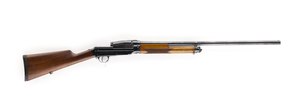Sjögren shotgun
Semi-automatic shotgun From Wikipedia, the free encyclopedia
The Sjögren Inertia Shotgun (marked: Automat, system Sjögren Patent)[2] is a 12–16 gauge semi-automatic shotgun that was designed by the Swedish inventor Carl Axel Theodor Sjögren, initially manufactured by AB Svenska Vapen- och Ammunitionsfabriken in Sweden[3] and then by Håndvåbenværkstederne Kjøbenhavn in Denmark.[1][4] It used an inertia system later revived by the Italian firm Benelli and today widely used in shotguns.
| Sjögren Shotgun | |
|---|---|
 A Sjögren shotgun on display | |
| Type | Semi-automatic shotgun |
| Place of origin | Sweden |
| Production history | |
| Designer | Carl Axel Theodor Sjögren |
| Designed | Patents issued in 1900, 1903 and 1905[1] |
| Manufacturer | AB Svenska Vapen- och Ammunitions Fabriken, Stockholm[1] Håndvåbenværkstederne Kjøbenhavn, Copenhagen |
| Produced | 1908–1909 |
| No. built | c. 5,000 |
| Variants | None |
| Specifications | |
| Cartridge | 12 gauge 16 gauge[2] |
| Action | recoil[3] |
| Feed system | 5-round internal magazine, tubular magazine on shotgun, box magazine on rifle |
| Sights | bead |
A small number of semi automatic military rifles in 7.62×63mm calibre were based on the Swedish Mauser using the Sjögren system, fed from internal seven round magazines, were also built, and tested by potential buyers, but found no market.[1]
References
Sources
External links
Wikiwand - on
Seamless Wikipedia browsing. On steroids.
